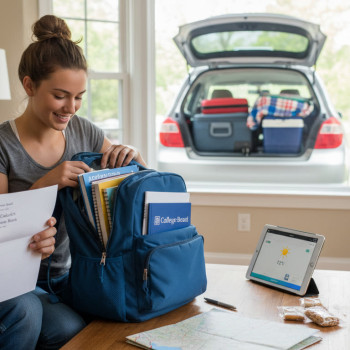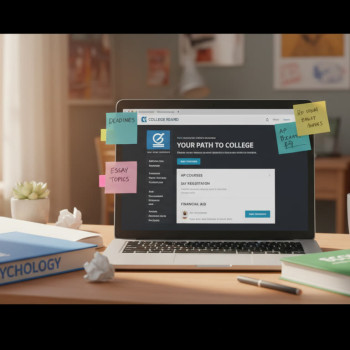Why This Guide Matters
If you or someone you care about is preparing for Advanced Placement (AP) exams and uses testing accommodations, welcome. This is the practical, human guide you wished you had earlier—clear, compassionate, and written for students and families who want to understand how extra time, breaks, and special exam formats work for AP testing.
Accommodations aren’t a shortcut; they’re an equalizer. They help you show what you really know instead of showing what an exam environment makes hard. By the end of this article you’ll understand the common accommodation types, how to request them, what changes with digital AP exams, and how to prepare so the day of the test feels familiar and calm.

Understanding the Big Picture: Who Approves Accommodations?
College Board’s Services for Students with Disabilities (SSD) oversees accommodations for AP exams. Approval usually requires documentation that demonstrates how a disability affects testing, and most students work through their school’s SSD coordinator. If your school already provides accommodations (for example through an IEP or 504 Plan), that often means you’ll be eligible for similar supports on AP exams—but the College Board must approve them in advance.
There are two important things to remember:
- Approval is program-specific. An accommodation approved for SAT or PSAT may also apply to AP, but sometimes adjustments are necessary for specific AP subjects.
- Timing matters. Requests and any required documentation must be submitted well before the exam. Each year the College Board publishes deadlines—so start early.
Accommodation Categories Explained
Accommodation requests can fall into several categories. Below is a friendly breakdown so you know what to ask for and what to expect.
Extended Time
Extended time increases the official time allotment for an exam. It is one of the most commonly requested accommodations. Depending on the approval, students might receive time-and-a-half, double time, or another increment tailored to their needs. Important: extended time for one subject doesn’t automatically apply to all subjects—approvals can be subject- or task-based.
Extra Breaks, Extended Breaks, and Breaks as Needed
Break accommodations are nuanced—and that’s okay. The College Board generally distinguishes between:
- Extra Breaks: a set extra break applied at a particular point in the exam (for example, an additional five-minute break in each section).
- Extended Breaks: a longer break than normal, often applied between sections to allow for rest, medication, or other needs.
- Breaks as Needed: the ability to pause the exam when necessary. For digital exams this often translates into a pause feature; for paper or hybrid formats it may require procedure adjustments.
Alternate Formats
Alternate formats ensure the exam is accessible. Common options include:
- Large-print or braille versions for students with visual impairments.
- Electronic formats compatible with screen readers or magnification tools.
- Audio or human reader supports, where a reader presents the test content aloud or the student uses text-to-speech options.
Human Supports: Readers, Scribes, and Assistants
Some students need a human reader (to vocalize questions) or a human scribe (to record responses). With technology advances, some previously human-mediated accommodations may now be offered via embedded tools—like text-to-speech or dictation—but human supports are still available when they’re the most appropriate solution.
Assistive Technology
Allowable devices range from simple magnifiers to full-featured speech-to-text or specialized software. For digital AP exams, many assistive tools are built into the platform or available as approved accommodations.
How Requests Work (Step-by-Step)
Don’t let the process intimidate you. Below is a straightforward flow of how most students secure accommodations for AP exams.
- Speak with your school’s SSD coordinator as early as possible. They’ll know the school’s usual cadence and the College Board’s current procedures.
- The SSD coordinator submits the request through the College Board’s SSD online system. Your role: provide clear documentation and advocate for the supports you use in school.
- College Board reviews the request and, if needed, asks for additional evidence. Once approved, you’ll get an eligibility letter—bring that to the exam.
- If you need to request accommodations without school involvement (for example, if your school cannot submit the request), there are paper form processes through College Board for families to use, though working with the school is generally faster and easier.
Important Timing Notes
Because deadlines update annually, always check the current academic year’s schedule. Generally, accommodations requests have a major winter deadline for spring exams—missing it can complicate arrangements for exam materials or digital formats. If you have a temporary condition (a broken arm, for example), there are paths to request temporary supports—these often have tighter timelines.
Digital AP Exams vs. Paper AP Exams: What Changes?
The growing shift to digital AP exams makes accessibility both more flexible and, in some ways, more complex. Many digital platforms have built-in accessibility features—text-to-speech, adjustable fonts, pause functions—but how an accommodation is implemented may differ from the paper world.
Here are the practical differences students commonly experience:
- Extended time and extra breaks are frequently implemented as adjustments to the digital exam timeline or as pause features.
- Some accommodations that required human support on paper (like a reader) can now be delivered as embedded technology. If a human reader is still required, coordinators must request that explicitly.
- Ordering special formats—braille, large print, or audio—requires the school AP coordinator to include those needs when ordering exam materials.
Quick Reference Table: Accommodation Types and What They Mean
| Accommodation | Typical Implementation | Notes for Digital Exams |
|---|---|---|
| Extended Time | Time-and-a-half, double time, or customized increment | Platform timer adjusted; may interact with pause functionality |
| Extra Breaks | Additional short breaks at set points | Extra break applied automatically or via pause; some pauses count as checkpoints |
| Extended Breaks | Longer than standard break between sections | May be scheduled between sections; coordinator must order appropriately |
| Breaks as Needed | Ability to pause when required | Pause feature available; still must be requested for approval |
| Alternate Formats | Braille, large print, audio, electronic files | Digital formats often include accessible files or embedded tools |
| Human Reader / Scribe | Person reads or records responses | May be replaced by text-to-speech or dictation if appropriate; request explicitly if human required |
Practical Tips for Students and Families
Preparation reduces anxiety. These practical tips help you make the process predictable and useful.
Start Early and Communicate
Begin conversations with your SSD coordinator well before exam season. Even if your school provides the same supports during the year, the AP process requires College Board approval. Give your SSD coordinator time to collect documentation and submit requests.
Document What Works
Make a short list of the supports that help you most in daily schoolwork: extended time for reading assignments, extra breaks to manage fatigue, the need for a reader for long passages—these real-world examples strengthen your case when documented by teachers or specialists.
Test the Tools Ahead of Time
When possible, practice on the same digital platform or with the same assistive tools you’ll use on test day. Familiarity with a text-to-speech voice, a magnifier, or a speech-to-text engine can turn a stressful unknown into reliable routine.
Order Special Exam Formats Early
If you require a large-print or braille version, your school’s AP coordinator must order those materials when the exam order is placed. That’s why early planning and clear communication between SSD and AP coordinators matter.
Bring Your Eligibility Letter
On exam day, bring the College Board SSD Eligibility Letter or any verification your school provides. It speeds check-in and prevents last-minute confusion.
How to Advocate for Yourself in a Calm, Effective Way
Advocacy doesn’t have to be loud to be effective. Think of it as clear, persistent communication.
- Make a checklist of what you rely on academically and why; share this with teachers and the SSD coordinator.
- Ask your SSD coordinator for expected timelines and confirmations when requests are submitted.
- If you’re denied an accommodation you think you need, ask for an explanation and whether additional documentation would help.
Study Strategies When You Have Accommodations
Accommodations level the playing field, but you still need targeted preparation. The following strategies are suited to students who may have more time, breaks, or alternative formats during the exam.
Simulate Real Conditions
Practice full sections with the same timing rules you’ll have on test day. If you’ll get extended time, practice with that extended window occasionally—but also practice with time-and-a-half or normal time to keep pacing skills sharp.
Break-Focused Practice
If you’ll have break accommodations, incorporate short breaks into practice sessions so you learn to reset quickly. Use the break for stretching, breathing, or a quick snack—avoid checking social media to keep your mind in test mode.
Use Assistive Tools During Study
Train with the same assistive technology (screen reader voice, dictation software, magnifier) you’ll use on exam day. The muscle memory and comfort you build will reduce cognitive load during the test.
Work on Executive Skills
For many students, accommodations address processing or physical barriers—but executive skills like structuring an essay or parsing a long math problem also matter. Short, structured coaching sessions can make a big difference here. Personalized tutoring—such as Sparkl’s 1-on-1 guidance—can help create tailored study plans, target weak spots, and practice under the specific timing and format conditions you’ll experience.
What to Expect on Exam Day
Arrive with your SSD Eligibility Letter and a clear plan. If you’re in a separate room for accommodations, expect a slightly different check-in process and someone to verify that your approved accommodations are in place. If you’re taking a digital exam with embedded tools, confirm that the tools are enabled before the test begins.
Staying calm is key. Use your practiced break routine and remember: the accommodation exists because you need it to show your knowledge—use it confidently.
Common Questions Students Ask
Will accommodations make my test score look different to colleges?
No. Colleges receive the same AP score reports. Accommodations are confidential adjustments to test administration so students can perform to their ability; they do not flag a student’s file or change the meaning of the score itself.
If I had accommodations before, do I have to apply again?
Not always. Approvals from College Board typically remain in effect across programs for a period of time after graduation, but there are nuances. Some accommodations need to be requested separately for AP (extra breaks, for example). When you change schools, move, or start using different tools, you should confirm that your approved accommodations still fit your needs and the specific AP subject.
How do temporary accommodations work?
For short-term conditions—an injury or medical event—schools can request temporary supports. These requests often have tighter windows, especially for digital exam dates, so communicate early and provide any required documentation promptly.
Checklist: Preparing for AP Exams with Accommodations
- Talk to your SSD coordinator as soon as possible.
- Collect documentation from teachers or clinicians that describes how the disability affects testing.
- Confirm the exact accommodations approved and which AP subjects they apply to.
- Practice with the same timing and tools you will use on test day.
- Ensure your AP coordinator includes any special format materials when ordering exams.
- Bring your SSD Eligibility Letter to the exam and arrive early to check-in.
How Personalized Tutoring Can Help
Preparing for AP exams when you use accommodations benefits from a tailored approach. Personalized tutors can model pacing strategies for extended time, run practice sessions that include planned breaks, and help you master subject-specific skills so you’re working smarter during your extra minutes—not just longer. If you’re exploring tutoring, look for options that offer 1-on-1 guidance, tailored study plans, expert subject tutors, and meaningful insights—both human and data-driven—to track progress. Sparkl’s personalized tutoring, for instance, focuses on these elements to help students translate accommodations into advantage: a trusted routine, clear pacing strategies, and targeted practice aligned with approved exam formats.
Real-World Example: Mia’s Story
Mia is a junior who’s approved for time-and-a-half and breaks as needed due to a processing disorder and chronic fatigue. She practices AP Biology in 90-minute blocks that mimic her extended-time windows, using dictation software for free-response practice so she’s fluent with the tool. On exam day she brings her SSD eligibility letter, checks in early, and calmly uses her pause routine during the digital exam. Her tutor helped her refine how to use the extra time—what to do first, when to move on, and how to use breaks to reset—so the additional minutes translated into higher-quality answers rather than stress-filled extra minutes.
When Things Don’t Go as Planned
Occasionally, an accommodation may not be set up correctly at the testing site. If that happens:
- Politely stop the test administrator and explain the discrepancy.
- Ask to see the AP coordinator or the person designated to manage accommodations.
- Document what happened and follow up with your SSD coordinator after the exam to report the issue and discuss next steps, including possible score reviews if your testing conditions were affected.
Final Thoughts: Your Preparation, Your Pace
Accommodations are about fairness, not advantage. They protect your opportunity to show knowledge under conditions that reflect your abilities. Approach the process proactively: document, request early, practice with the tools and timing you’ll use, and build test-day routines that let you focus on the content—not the mechanics.
If you want structured practice tailored to your approved accommodations, consider seeking 1-on-1 tutoring that adapts to your timing and format needs. Personalized tutoring can be especially valuable for pacing strategies, tool familiarity, and confidence-building. With planning and the right practice, exam day becomes less about managing logistics and more about demonstrating what you know.

Quick Resources Summary (What to Do Next)
- Contact your school’s SSD coordinator and start the conversation today.
- Gather documentation and examples of accommodations that help you in class.
- Practice with the same digital tools and timing you’ll use on exam day.
- Plan your study schedule around realistic, accommodation-aware practice sessions.
- Consider targeted, personalized tutoring for pacing and tool training to make your accommodations count.
Parting Words
Facing AP exams with accommodations is a testament to your determination and preparation. The system may feel bureaucratic at times, but its purpose is simple: to let you demonstrate what you know. Be persistent, plan early, practice smart, and don’t hesitate to ask for support—both from your school and from tutors who understand how to turn accommodations into a strategic advantage. You’ve got this.
Good luck—and remember, preparation is the clearest path to confidence. If you want help building a study plan that matches your accommodations and test format, a personalized tutor can help you practice exactly the way you’ll be tested.
























No Comments
Leave a comment Cancel